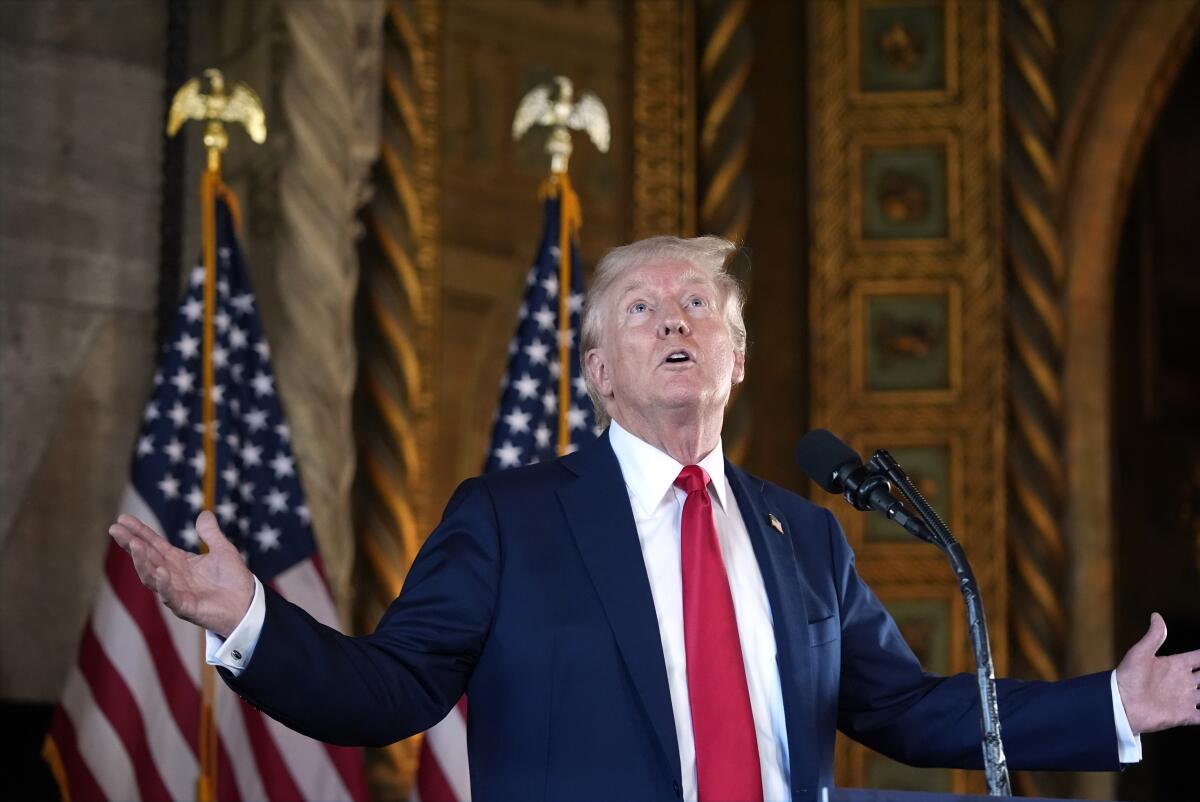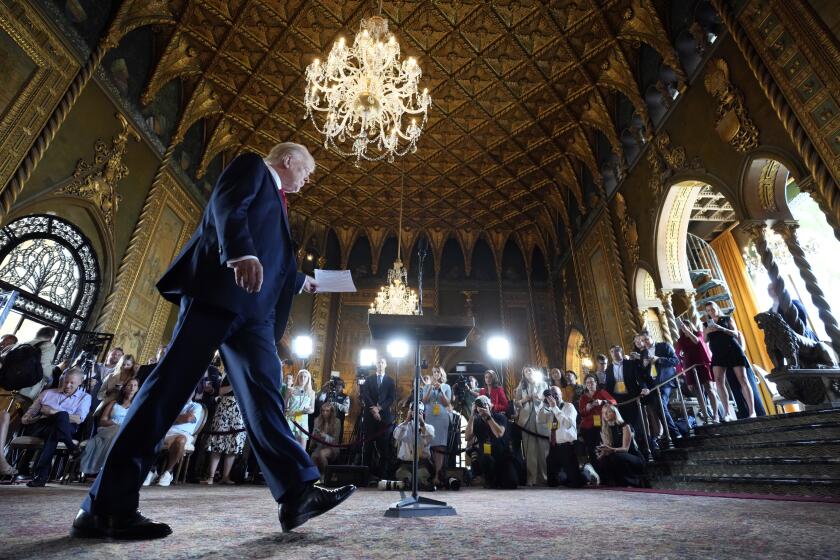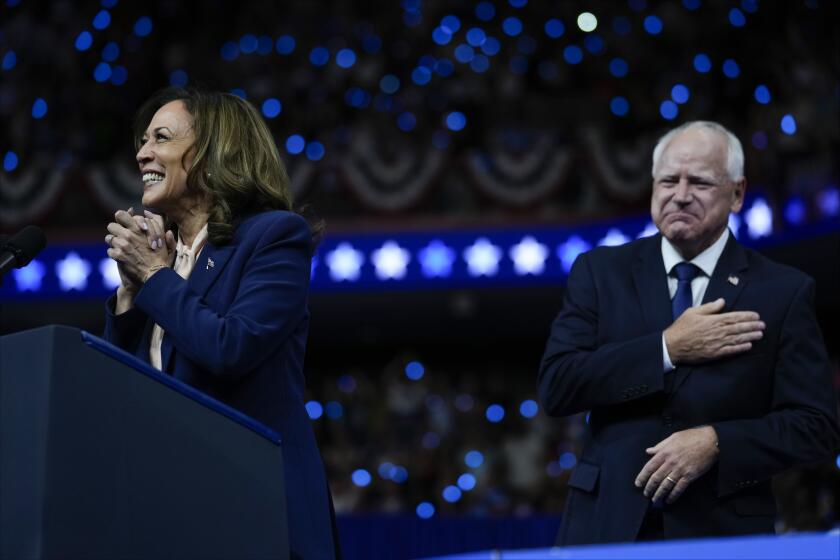Trump campaign looks to young male voters for an edge on Harris

- Share via
WEST PALM BEACH, Fla. — As Donald Trump adjusts to the reality of his new race against Kamala Harris, his campaign is counting on younger male voters to give him the edge in November in a presidential contest they insist is his to lose.
Trump and his Republican campaign face a dramatically different race than the one just three weeks ago, before President Biden abandoned his bid. Though they acknowledge polls have tightened with Harris as the Democratic nominee, they maintain that the fundamentals of the race have not changed.
“What has happened is we are witnessing a kind of out-of-body experience where we have suspended reality for a couple of weeks,” Trump campaign pollster Tony Fabrizio told reporters in West Palm Beach last week.
It was a message echoed by Trump during a news conference at his Mar-a-Lago club.
In a rambling 65-minute exchange with reporters, Trump relents on debate next month -- while lobbing insults at Harris, making wild and misleading claims and portraying the U.S. in apocalyptic terms.
“The honeymoon period’s gonna end,” he insisted while minimizing the size of the crowds Harris has been drawing and lashing out at his new opponent. “Let me tell you: We have the enthusiasm.”
Campaign officials acknowledge that Harris had energized the Democratic base and that her team has taken the lead on fundraising. But they insist they have more than enough to do what they need to win. Trump’s campaign and its affiliates reported raising $138.7 million in July — far less than the eye-popping $310 million sum reported by Harris. Her campaign began August with more cash on hand.
With less than three months to go, senior campaign officials are focused on a group of persuadable voters that they believe is key to victory. The targets, which they say account for about 11% of the electorate in key battleground states, skew younger and are disproportionately male and moderate. While more than half are white, they include more nonwhites, especially Asian and Latino voters, than the broader electorate.
They are especially frustrated by the economy, including their personal finances, and are pessimistic things will improve.
“It’s a very narrow band of people that we are trying to move,” Fabrizio said of the efforts. Since these voters don’t engage with traditional news outlets and have traded cable for streaming services, the campaign has been working to reach them in novel ways.
Harris, Walz emphasize ‘freedom’ and ‘joy,’ and press attacks on Trump, Vance in raucous first rally
In Philadelphia, Kamala Harris and Tim Walz make a lively first joint appearance as the Democratic Party’s nominees for president and vice president.
“There is a reason why we’re doing podcasts. There is a reason why we’re doing Adin Ross,” Fabrizio said, referring to the controversial internet personality who ended his recent interview with the former president by giving him a Tesla Cybertruck wrapped in images of Trump raising his fist after an attempted assassination.
“There is a reason why we are doing all of those things. You know what these people pay attention to? MMA, Adin Ross,” he said. “MMA” refers to mixed martial arts.
Trump campaign officials acknowledge the Democratic base is motivated in a way it wasn’t when Biden was the nominee. Harris, they say, will likely do better than Biden would have with Black voters, especially women and older men.
But they intend to paint her as a radical liberal and as the incumbent rather than a change. By the end of the race, they believe, neither candidate will be liked, but voters will choose the candidate they feel will most improve their economic conditions.
They pointed to a line Harris has been using to refer to Trump’s presidency — “We are not going back” — as ill conceived, given that some voters say things were better when Trump was in office than they are now.
Trump campaign aides said they now have staff on the ground in 18 states, including critical battlegrounds and states such as Virginia, where Democrats have been favored, that they hope they can put into play.
The campaign says it now has hundreds of paid staffers and more than 300 Trump and GOP offices open across battleground states. The Harris campaign, meanwhile, says it has 1,500 paid staffers and 265 offices across the country.
But much of the Trump effort relies on volunteers and outside groups.
They are trying to replicate a model they used successfully during the GOP primary in Iowa this winter, where volunteer “caucus captains” were given a list of 10 neighbors they pledged to get out to the polls. The campaign has credited that model with boosting turnout on a brutally cold and icy caucus night.
The “Trump Force 47” program is focused on targeting low- and medium-propensity voters. Volunteers will be canvassing, writing postcards, phone banking and organizing their neighbors.
So far, 12,000 captains have been trained and given voter target lists, according to officials. An additional 30,000 have volunteered.
A large part of the campaign’s outreach will also rely on outside groups, which will be running paid canvassing and get-out-the-vote efforts thanks to new guidance from the Federal Election Commission that allows campaigns to coordinate with outside groups in ways that were previously not allowed.
The Harris campaign, meanwhile, says it is amassing its own army of volunteers. In the first two weeks of her candidacy, they said, 200,000 volunteers joined the campaign and signed up for 29,000 canvass shifts and 197,000 phone banking shifts.
“The reality is, Donald Trump and his orbit were late to build a program, and they’re now scrambling to play catch-up,” said Harris-Walz battleground director Dan Kanninen in a statement.
In an election that is expected to be extremely close, he said, “building an effective and disciplined field operation, and being able to be in communities and build trust and relationships for months as we have, is absolutely essential. The Trump campaign simply isn’t doing it.”
Colvin and Price write for the Associated Press.
More to Read
Sign up for Essential California
The most important California stories and recommendations in your inbox every morning.
You may occasionally receive promotional content from the Los Angeles Times.












